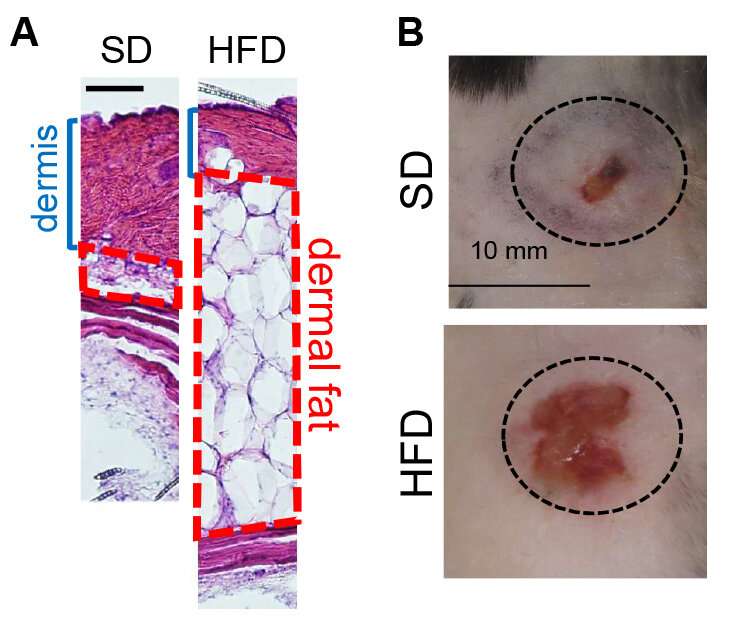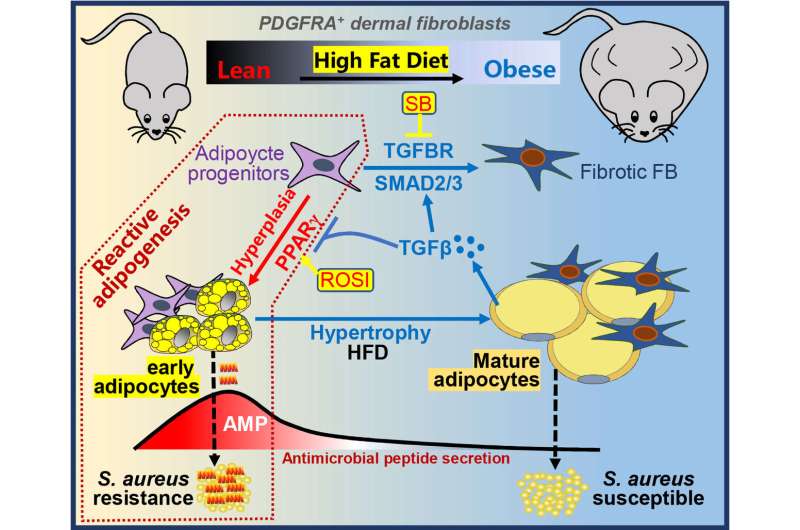February 25, 2021 feature
Research identifies obesity and infection link

The list of diseases and conditions complicated by obesity is a long one; it includes heart disease, cancer, diabetes and impaired wound healing, as well as skin infections. It is not always clear, however, in what way this complication is caused. New research from the School of Pharmaceutical Science at Xiamen University and the Gallo Lab at UC San Diego School of Medicine, published last month in Science Translational Medicine, has uncovered the mechanisms that link obesity and skin infections, and identified a treatment option that will soon be tested in a Phase 2 clinical trial.
The work is focused on discovering links between disease and the epithelial microbiome—that is, the normal bacteria that live on our skin—and how the skin's defense system can be optimized to treat or prevent disease. In this study, the goal was to identify how obesity contributes to higher rates of bacterial infection. "Obesity is associated increased risk for skin infection, but how obesity impairs our immune system is not clear," explains Dr. Ling-juan Zhang, School of Pharmaceutical Science at Xiamen University and lead researcher on the study. "We have found that when mice are fed a high fat diet and become obese, skin adipocytes (or fat cells) become enlarged and lose the ability to fight against bacterial invasion during an skin infection."
The findings revealed that an increased number of mature adipocytes (fat cells) increases TGFβ signaling, which in turn decreases the number dermal adipocyte progenitors that produce an antimicrobial peptide called cathelicidin. This absence leaves the epidermis vulnerable to infection from common culprits like Staphylococcus aureus. In lean subjects (both mice and human in this study), the skin microbiome was successful in preventing Staph infections, as the number of mature fat cells was insufficient to disrupt the normal dermal fat functions that keep such infections at bay.
"Normally, skin fat cells can rapidly respond to invading bacteria, and produce a molecule called antimicrobial peptide, which is the antibiotics produced by our own cells, to kill bacteria. However, upon obesity, the enlarged skin fat cells lose the ability to produce antimicrobial peptides, and this is mediated by a cell signaling protein transforming growth factor beta or TGFβ, which is produced by the enlarged fat cells and negatively impacts antimicrobial peptides during obesity," says Dr. Zhang.

Next, the team hoped to find a treatment option that would work safely and effectively for most patients. Prevention, as always, is better than cure. Dr. Zhang explains: "Our study shows how an unhealthy diet and obesity can impact the skin's ability to fight against bacterial infection, and will help to educate individuals on the importance of a healthy diet and life style that includes regular exercises to prevent accumulation of enlarged fat cells that may negatively impact the antimicrobial function of our skin."
For obese individuals already experiencing atopic dermatitis, the team is in search of effective treatment options. They turned again to the skin microbiome of healthy individuals for clues. "We are currently investigating new therapies, including new agents to block TGFβ action and stem cell therapy, to treat obesity-associated skin infection," says Dr. Zhang.
"Fat is not all ways bad, and healthy adipocytes are necessary for our body to fight against infection," Dr. Zhang explains. "Luckily, fat cells are highly plastic and regulatable, and the antimicrobial activity of obese fat cells can be restored through interventions, such as switching to a healthy diet, regular exercise and targeted drugs or therapies."
Research into those targeted therapies is ongoing, and the options are interesting. Dr. Zhang explains: "Stem cells that can turn into healthy fat cells maybe used as potential therapy to regenerate healthy fat cells that can produce antimicrobial peptides in the obese skin to help to fight against infection."
More information: Ling-juan Zhang et al. Diet-induced obesity promotes infection by impairment of the innate antimicrobial defense function of dermal adipocyte progenitors, Science Translational Medicine (2021). DOI: 10.1126/scitranslmed.abb5280
© 2021 Science X Network



















